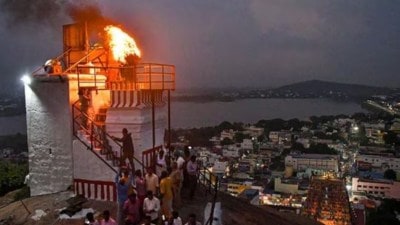Amid delays in plans for large-scale deployment of Fast Breeder Reactors (FBR) — the vital second stage of India’s three-stage atomic energy programme — one of the country’s top nuclear scientists has said that a solution could lie in the country’s policy makers looking at fuel cycle options instead of reactor options.
The delays in FBR deployment is bad news for India’s nuclear programme, given that these reactors envisaged the use of recycled fuel while breeding much more fissile fuel.

How India can side-step FBR deployment delays
A quick solution to tide over this problem could lie in irradiating thorium — the radioactive metallic element named after the Norse god that has been a long standing hope for India’s true energy security — along with a fuel variant called high assay, low enriched uranium (HALEU) in the country’s pressurised heavy-water reactors (PHWRs) at scale, Anil Kakodkar, former director of Bhabha Atomic Research Centre, told The Indian Express.
The used fuel from these PHWRs — the mainstay of India’s nuclear power programme — can then be recycled to set up additional power generation capacity, including through the new-age molten salt reactors (MSRs) as part of the third stage of India’s three-stage nuclear power development programme.
HALEU is defined as uranium enriched to greater than 5 per cent and less than 20 per cent of the uranium-235 (U-235) isotope, which is different from the uranium fuel enriched up to 5 per cent U-235 that is typically used in the current fleet of light water reactors deployed by most western countries.

Applications for HALEU are currently limited to research reactors and it is not yet widely available commercially. This also comes at a time when China is planning to build a nuclear power plant on the edge of the Gobi Desert that would be the first in the world to use molten salt as the fuel carrier and coolant, and the first to use thorium as a fuel source instead of the uranium traditionally used in nuclear reactors.
Kakodkar’s comments are timely, given the need for baseload nuclear capacity and thermal capacity that is clearly being felt currently in India after a phase of rapid expansion of renewables power generation capacity over the last decade. The absence of energy storage systems to counterbalance the renewable capacity is now resulting in increasing instability in the country’s electricity grid. Renewable energy sources such as solar and wind rely on specific atmospheric conditions to generate power, producing electricity only when the sun is shining or the wind is blowing.
Story continues below this ad
While nuclear, alongside thermal, is being seen as a solution to ramping up base load capacity, the slow pace of atomic power capacity addition is a big constraint.
How to increase India’s nuclear power output
According to Kakodkar, while the government’s move to acknowledge the inevitable role of nuclear energy in the realisation of its ‘Viksit Bharat’ goals is positive, the setting up of 100 GWe of nuclear capacity by 2047 would be a challenge.
“The only way to exponentially increase the rate of nuclear power output, given the supply constraints on uranium, is to start recycling uranium and bringing in thorium into the (generation) mix as early as possible,” Kakodkar said. Recycled nuclear fuel would then be necessary to sustain the capacity addition growth rate. For that the FBR was seen as crucial, but delays had dogged the large-scale deployment of these reactors.
As an improvisation, by using thorium irradiated along with HALEU in the PHWRs at scale, the spent fuel produced can then be recycled to set up additional power generation capacity, including through the molten salt reactors.
Story continues below this ad
Kakodkar said that while recycling spent uranium fuel along with plutonium in fast reactors remains a superior option, given the delays in India’s FBR project, recycling the HALEU-thorium fuel is perhaps the next best alternative. This would enable India’s civil atomic power programme to grow as long as the irradiated fuel feed is available, he said.
Kakodkar said that while the government’s plans to establish a number of Bharat Small Reactors in a public-private partnership mode make sense, there is no harm in India being open to all available nuclear technologies, including imported light water reactors. While the 700 MWe PHWRs, currently being deployed in fleet mode, can be the main basis for capacity addition, small reactors could “play a supporting role”.
HALEU-thorium fuel can be leveraged in both to enable the continuation of capacity addition beyond the time uranium supply constraints, and the continuing delays in the FBR programme.
Can the private sector lead India’s nuclear power journey?
According to Kakodkar, the private sector, while it needs to be mobilised to scale up the programme has, at best, “a secondary role”.
Story continues below this ad
That is an argument which is countered by other experts, given the inability of the public sector to expedite nuclear capacity addition. “The inability to scale up is a management issue, and not a technology issue,” Kakodkar said. He also said that nuclear power today is competitive without any subsidy, and so be given must-run status, and should be backed up by a clean energy fund, just like for renewables.
The Department of Atomic Energy’s three-stage power programme envisages a pathway to utilising India’s abundant thorium reserves — found in coastal sands on the beaches of Kerala, Tamil Nadu, Odisha, Andhra Pradesh, Maharashtra, and Gujarat, and in the inland riverine sands of Jharkhand and West Bengal — to generate electricity.


































